Affairs of the Art – Interview with Joanna Quinn and Les Mills Part 1
After 15 years Beryl, the character who made the animation world aware of Joanna Quinn returns in a brand new film Affairs of the Art, produced with the National Film Board of Canada. Alongside writer/producer Les Mills, the duo have produced not only the Beryl series of films, but also an impressive back catalogue of well loved advertisements, TV specials such as Famous Fred as well as mesmerising short films such as Britannia and Elles, all which carry the signature pencil strokes and biting humour that the partnership has become renown for.
After a 33 year journey which started with 1988’s Girl’s Night Out, Beryl is back and she has brought her family along with her. The latest short offering focusses not only on the artistic obsession of the familiar welsh housewife, but shares the obsessions of the family that surround her, particularly her geeky son Colin, who’s penchant for screw threads, pigeons, the dutch language and feline revenge would make him the stand out candidate for ‘weirdest person in the film’ were it not for Beverly, the older sister of Beryl, last heard in Dreams and Desires: Family Ties.
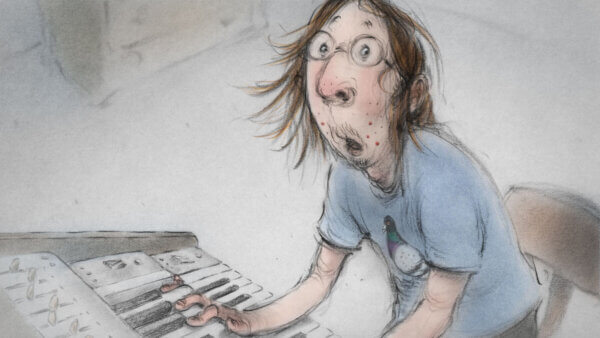
Meet Colin, Beryl’s obsessive offspring © NFB and Beryl Productions International
Through Beverly the film explores more grotesque, but still gigglesome preoccupations as we witness the transformation of young Beverly from a goofy looking schoolgirl obsessed with death, through a journey of pickling and preservation that leads to her modern incarnation as a high flying Hollywood mogul. Every new biographical revelation presents a hilarious, rich character that steals the show in-between Beryl’s own comical lamentations and paint covered attempts to conquer the art world. When the film is over you want to spend more time with these well constructed oddballs, but you’re glad you don’t know them in real life.
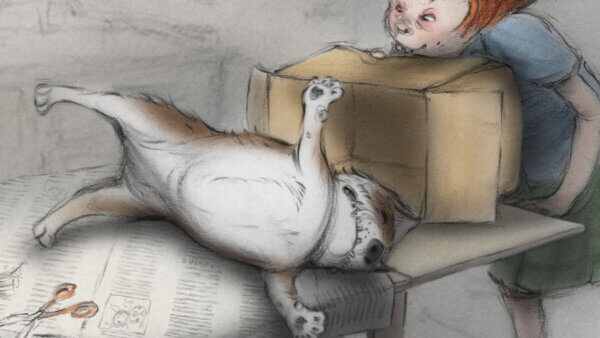
Gruesome giggles – Beverly in Affairs of the Art © NFB and Beryl Productions International
Ahead of the films premiere at 2021 Clermont-Ferrand International Short Film Festival we caught up with writer/producer Les Mills and director/lead animator Joanna Quinn to get us up to speed with the new film and to find out what gives Beryl her enduring appeal in part one of a two part interview.
I’d like to start by heading back in time to the first Beryl Film (Girl’s Night Out) and how your working partnership came to be.
Joanna Quinn: I was at college, it was my graduation film, I was on a graphic design course but I fell into animation as we were given it as a project, but I got hooked because we got to do lot’s of drawing which suited me fine. So I ended up focussing on animation, Les wasn’t teaching at the college at the time but we worked together on the film.
Les Mills: The idea of the character was already there in a sense, she has created a comic strip of it. It was a simple idea which needed fleshing out which is what we did. For her end of year show all of the other students had lots of illustrations, fashion design and typography
JQ: But all I had was a telly!
LM: So I said ‘Jo, you have thousands of lovely drawings and cells, you should have your show but overlap the cels of the best sequence up on the wall.’ She did that and it looked fantastic! Originally the voices in the film were me, Phil Davies, Joanna and the woman who worked in the refractory.
JQ: Anyone who was available!
LM: We did a professional edit later and Joanna sent the film off to Annecy without telling me, she rang me up after and said ‘I won three prizes at Annecy!’ So that started Joanna’s career and people knowing Beryl.
At the time S4C was pumping lots of money into TV in Wales – people were actually moving to Wales to make stuff, Chris Grace (Commissioning Editor) asked us to write another Beryl film which is when we came up with Body Beautiful.
How did Body Beautiful find its story?
LM: The film was about Beryl, working in a Japanese factory in Wales, at the time Wales had more Japanese factories than anywhere else in the world outside of Japan. We went to four Japanese factories, I’d go and see how they worked, Joanna would go and draw and so we got to know the factories. We noticed that it was only women on the factory floor doing the circuit boards and all the men were managers, so I asked them and apparently it’s because women have better eyesight.
JQ: That sounds like a lame excuse!
LM: Because of that the people in our film look like the people from the factories we visited. Recently we’ve been looking at the film again and realising it was a statement about a particular time. People have moved on nowadays and people won’t accept conditions like they were then, so the film was a bit of an eye opener at the time.
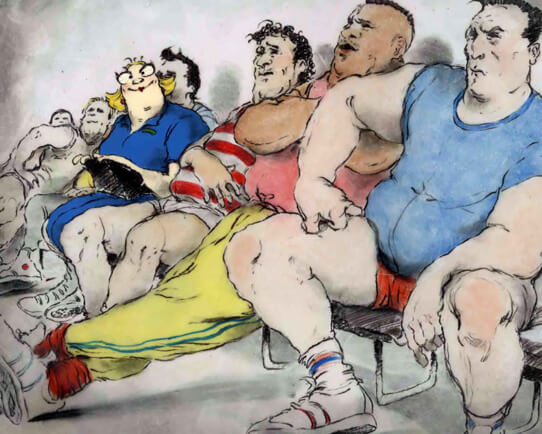
Body Beautiful (1990) © Beryl Production
JQ: It was also the first film that had a budget, so for me it was difficult because the idea of being professional – well, I’d never even thought of it! I’d made Girl’s Night Out intuitively, just playing around really, everything happened to work perfectly, I remember in the edit when we added ‘The Stripper’ music it ended just at the right time, and I remember thinking ‘Gosh, next time I make a film I’m going to make sure everything is timed’ It was all fluke!
LM: We were quite professional, holding auditions. We had a string of Welsh blokes coming in to audition and we had to find actors who could speak both English and Welsh so the films could be done in both languages. We got through about twelve blokes and none of them hit it off, suddenly a bloke came in who was very jaunty and alive and funny and worked the lines we gave him and we told him on the spot – ‘right, you’ve got it!’ and that was Rob Brydon.
After Body Beautiful did you actively go looking to make more Beryl films?
LM: After that we became known by S4C and channel four. We got to know people like Clare Kitson (commissioning editor Channel Four) who liked the shorts and told us ‘I’ve got this slot at 7:45 just before the 8pm news and I want five little animated ideas for it. We were delighted because most animation, even Fourmations only went out last thing at night. So we knuckled down and wrote five brand new Beryl shorts, got really excited, but then she resigned! We took the ideas and made Dreams and Desires: Family Ties. We made that in two years and it was incredibly successful. We had a couple of years after then where we enjoyed going to festivals.
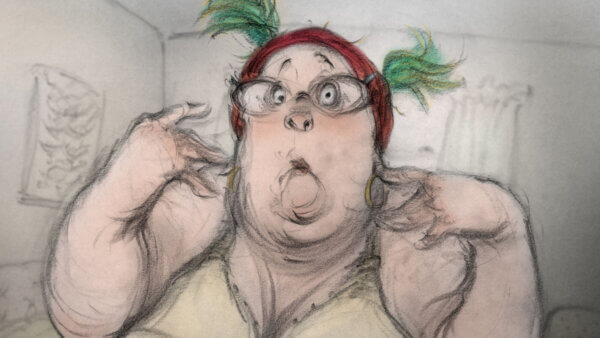
Affairs of the Art © NFB and Beryl Productions International
LM: At the same time we were doing ad’s and making films like Britannia, Famous Fred and stuff like that. We had a big crew, forty people at one time, they were good times.
JQ: We’ve always been super lucky to work with lovely, super talented people.
For yourselves as writers and directors, what appeals to you most about working with the character of Beryl?
JQ: We enjoy Beryl as a character because she’s very accessible and audiences seem to really like her. She’s a little bit of an anti-heroine, she has a go, fails and succeeds. I think she has lots of foibles and weaknesses, so you can have fun with her. What’s really nice is, because she’s not really vocal it’s not all show so when you animate her a lot of the acting is what she’s thinking so you’re able to show that off with facial expressions, so you’re trying to get the character across with her body language so it’s not all about the dialogue, it’s deeper than that. With the last film we felt that we wanted to explore beyond Beryl and we wanted to introduce her family, that’s why there’s more of her family in AOTA than there is Beryl, Beryl is the narrator but we get introduced to her sister and her husband and her son Colin, so she talks about her family, though she’s very present visually we see more of the other character, so that was really nice, that was new for us. We did think ‘oh gosh, another Beryl film’ and we didn’t want to do the same thing over and over again so we wanted to expand it a bit.
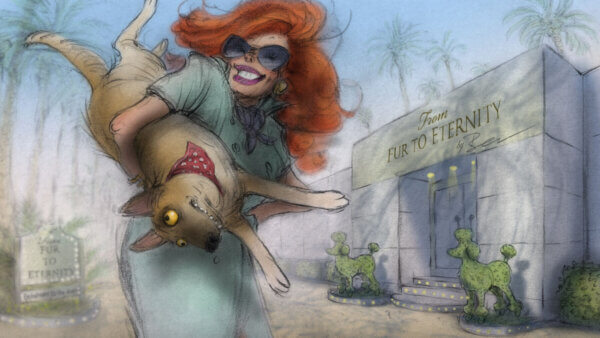
Affairs of the Art © NFB and Beryl Productions International
LM: I’m a bloke and Beryl is a woman and I have to bear that in mind when writing her, but it’s nice to be able to concentrate on other character with strong personalities as well. Some of the things I wrote for Clare Kitson never got made, so I took some of them and added them together for the new film. There was one film we were going to make called Beverly Thrills which was all about Beverly making it big in Hollywood and Beryl going to visit her, it wasn’t a very good script anyway but I took Beverly out of it and stuck it in this film and developed her character – how did she manage to end up in LA mixing with celebrities when she was just a nobody from Wales with an incredible obsession? So it became a film about her family and obsessions. I’ve never met anyone like Beverly but Colin (Beryl’s son) is based on my brother, there are parts of the film that I saw my brother do as a kid that stuck with me and are in the film, it’s very much observational.
French audiences can attend the online edition of Clermont-Ferrand International Short Film Festival and catch Affairs of the Art there. Other audiences will have to wait a while longer but fear not, as part two of our interview can be read here.


